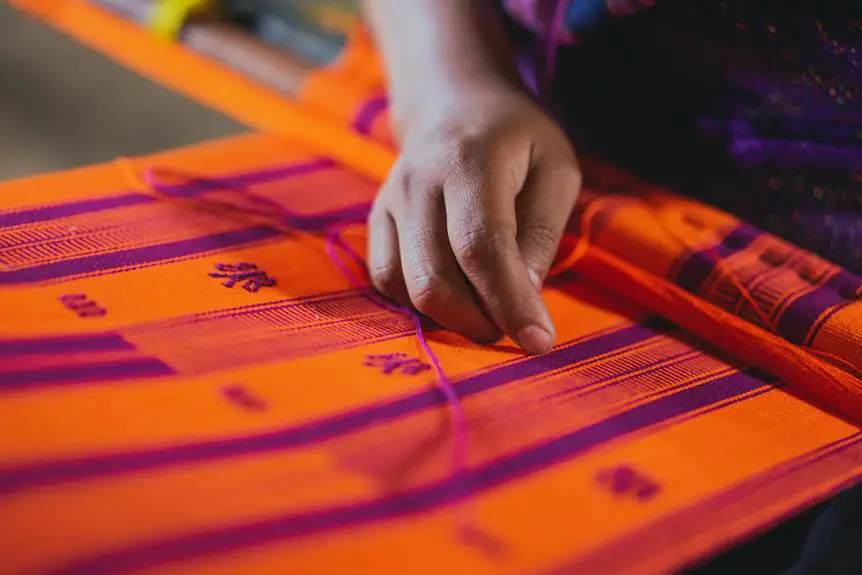If you're just starting out in embroidery, exploring essential techniques can set a strong foundation for your skills. You might want to begin with the backstitch for clean outlines or the simple running stitch for its versatility. Don't overlook the charm of the chain stitch or the polished finish a satin stitch can provide. Each technique not only enhances your work but also encourages creativity. Understanding the nuances can be key to your progress, so let's explore what makes each technique unique and how they can elevate your projects.
Table of Contents
Key Takeaways
- Start with Backstitch Basics for strong outlines and defined shapes, enhancing detail in your embroidery projects.
- Practice the Simple Running Stitch to create evenly spaced stitches, perfect for outlining and filling areas.
- Learn the Chain Stitch Technique for decorative loops that add texture and variety to your designs.
- Experiment with French Knots to introduce dimension and whimsy, complementing other stitch types effectively.
Backstitch Basics
Backstitch is a fundamental embroidery technique that you'll find easy to master, allowing you to create strong, defined lines in your designs. This stitch is perfect for outlining shapes or adding detail to your work.
To get started, thread your needle and tie a knot at the end. Bring the needle up through your fabric at the starting point. Next, insert the needle back into the fabric a short distance away from the starting point, usually about 1/8 inch. Pull the thread through and then bring the needle back up again at the starting point of your previous stitch. This creates a backward stitch, hence the name. Repeat this process, ensuring each stitch is evenly spaced for a neat appearance.
As you practice, try varying the length of your stitches to create different effects. You can also experiment with using multiple strands of thread for a bolder look.
Remember to keep your tension consistent; too tight can pucker the fabric, while too loose may result in uneven lines. With a bit of practice, you'll be confidently using backstitch in your embroidery projects in no time!
Simple Running Stitch
The simple running stitch is a versatile technique that's perfect for beginners looking to add fluidity and movement to their embroidery designs. It involves creating a series of evenly spaced, straight stitches on your fabric, making it easy to master.
Start by threading your needle and tying a knot at the end of the thread. Bring your needle up through the fabric where you want to begin, then insert it back down about a quarter of an inch away.
Continue this process, alternating between bringing the needle up and down, ensuring your stitches are uniform in length. This stitch forms a delicate line that can be used for outlining shapes, filling in areas, or creating patterns. You can experiment with different lengths and spacing to achieve various effects.
The beauty of the running stitch lies in its adaptability; you can use it in different directions or layers to enhance your design. Plus, it's a great way to practice your control and precision.
French Knots Explained
French knots add texture and dimension to your embroidery, making them a fantastic complement to the simple running stitch you've just mastered. These little knots can elevate your designs and create a playful touch.
Here's how to make them:
- Thread your needle: Use a single strand of embroidery floss and thread it through the needle. Tie a small knot at the end.
- Insert the needle: Bring your needle up through the fabric where you want the knot to be.
- Wrap the thread: Before pulling the needle back down, wrap the thread around the needle twice.
- Finish the knot: Insert the needle back into the fabric close to where it came up, and pull through. Gently hold the wrapped thread as you pull to tighten the knot.
Practice a few times, and you'll find French knots can add whimsy and richness to your projects.
Don't worry if they're not perfect at first; with time, you'll master this charming technique!
Chain Stitch Technique
Chain stitch is a fundamental technique you'll want to master for your embroidery projects.
You'll learn the basic steps, explore various patterns, and discover common mistakes to avoid.
Let's get started on making beautiful chain stitches!
Basic Chain Stitch Steps
Begin by threading your needle and tying a knot at the end of your embroidery floss. The basic chain stitch is a great starting point for your embroidery journey. Here's how to create it step by step:
- Insert the Needle: Push the needle through the fabric from the back to the front, leaving a small loop of thread above the fabric.
- Create the First Stitch: Insert the needle back through the fabric a short distance away from the first point, then pull the thread through, forming a loop.
- Make the Chain: Bring the needle back up through the loop you just created, and pull tight. This secures the thread and forms the first chain stitch.
- Repeat: Continue this process, spacing your stitches evenly, and keep pulling the thread taut to maintain a consistent look.
Practice makes perfect, so don't worry if your first attempts aren't flawless. As you get the hang of it, you'll find the chain stitch adds a lovely texture to your embroidery projects.
Happy stitching!
Variations and Patterns
Once you've mastered the basic chain stitch, you can explore various patterns and creative variations to enhance your embroidery projects.
One exciting variation is the double chain stitch, where you create two loops instead of one. This adds depth and texture to your work, making it visually intriguing.
You can also try the spiral chain stitch, which involves stitching in a circular motion. This technique creates a beautiful spiral effect that can be used as a decorative element or a unique border.
Another fun variation is combining chain stitches with other stitches, like the backstitch or satin stitch. This combination can create stunning effects and intricate designs, allowing your creativity to shine.
Don't forget about color variations! Using different thread colors within your chain stitches can create stunning patterns that draw the eye. You might also consider varying your stitch size; larger stitches can give a bold look, while smaller ones offer a delicate touch.
Experimenting with these variations and patterns not only enhances your skills but also allows you to personalize your projects, making your embroidery truly one-of-a-kind.
Common Mistakes to Avoid
When practicing the chain stitch technique, it's easy to fall into a few common pitfalls that can affect your final design. Here are some mistakes to watch out for:
- Inconsistent Tension: If your thread tension varies too much, your chain stitches can look uneven. Make sure to keep a steady grip on your thread while stitching.
- Skipping Holes: It's tempting to skip a hole or two for speed, but this can lead to gaps in your design. Always stitch through each hole for a uniform look.
- Incorrect Stitch Length: If your stitches are too short or too long, it can throw off your pattern. Aim for consistency, keeping your stitches at a moderate length for the best results.
- Not Securing Your Ends: Failing to secure your thread at the start and end of your work can lead to unraveling. Make sure to knot or backstitch your ends to keep everything in place.
Whipped Backstitch
The whipped backstitch combines the strength of a backstitch with a decorative whip, creating a sturdy yet eye-catching outline for your embroidery projects. It's perfect for adding flair while ensuring durability.
To start, you'll want to execute a backstitch along your design's edge. Once you've established this foundation, you'll whip your thread around the same stitch as you go along. This technique not only enhances visual appeal but also reinforces the stitch itself.
Here's a quick reference table to help you understand the steps and benefits of the whipped backstitch:
| Step | Description |
|---|---|
| 1. Make a backstitch | Create a basic backstitch along the line. |
| 2. Whip the thread | Wrap the thread around the backstitch. |
| 3. Maintain tension | Keep your thread taut for an even look. |
| 4. Finish securely | Tie off at the end to secure your work. |
Satin Stitch Essentials
Satin stitch is a versatile technique that adds a smooth, polished finish to your embroidery projects, making it ideal for filling in shapes or creating intricate designs. To get started with satin stitch, follow these essentials:
- Choose the Right Fabric: Opt for a tightly woven fabric like cotton or silk. It allows for better control and a smoother finish.
- Select Appropriate Thread: Use embroidery floss or specialty threads. A shiny thread can enhance the satin effect, while a matte thread offers a subtle look.
- Plan Your Design: Sketch your design and decide which areas to fill. Outlining shapes beforehand can help you stay organized and efficient.
- Practice Consistency: Keep your stitches even and close together. Aim for a uniform width to achieve that signature satin sheen.
Once you've got the basics down, practice makes perfect! Start with simple shapes, and as you gain confidence, move on to more complex designs.
With patience and practice, you'll master the satin stitch, elevating your embroidery skills to the next level!
Frequently Asked Questions
What Materials Are Best for Beginners in Embroidery?
When starting out in embroidery, you'll want to use cotton fabric, embroidery floss, and a simple hoop. These materials are easy to work with, affordable, and perfect for honing your skills without overwhelming you.
How Do I Choose the Right Embroidery Needle?
To choose the right embroidery needle, consider your fabric type and thread thickness. Different needles have specific sizes and shapes, so match them accordingly to ensure smooth stitching and prevent damage to your materials.
Can I Use Regular Thread for Embroidery?
You can use regular thread for embroidery, but it might not give you the best results. Specialty embroidery threads are designed for durability and shine, helping your designs look vibrant and professional.
What Is the Best Fabric for Practicing Embroidery Techniques?
When you're practicing embroidery techniques, use cotton fabric. It's sturdy, easy to work with, and holds stitches well. You'll find it forgiving, allowing you to focus on mastering your skills without frustration.
How Do I Fix Mistakes in My Embroidery Work?
If you make a mistake in your embroidery, don't panic! You can carefully pull out the stitches with a seam ripper or tweezers, then re-stitch the area. Practice makes perfect, so keep going!
- How Does Ring Spun Cotton Affect Garment Fit and Shape Retention? - August 13, 2024
- What Are the Challenges in Producing Ring Spun Cotton? - August 13, 2024
- Is Ring Spun Cotton Suitable for Plus-Size Clothing? - August 13, 2024






